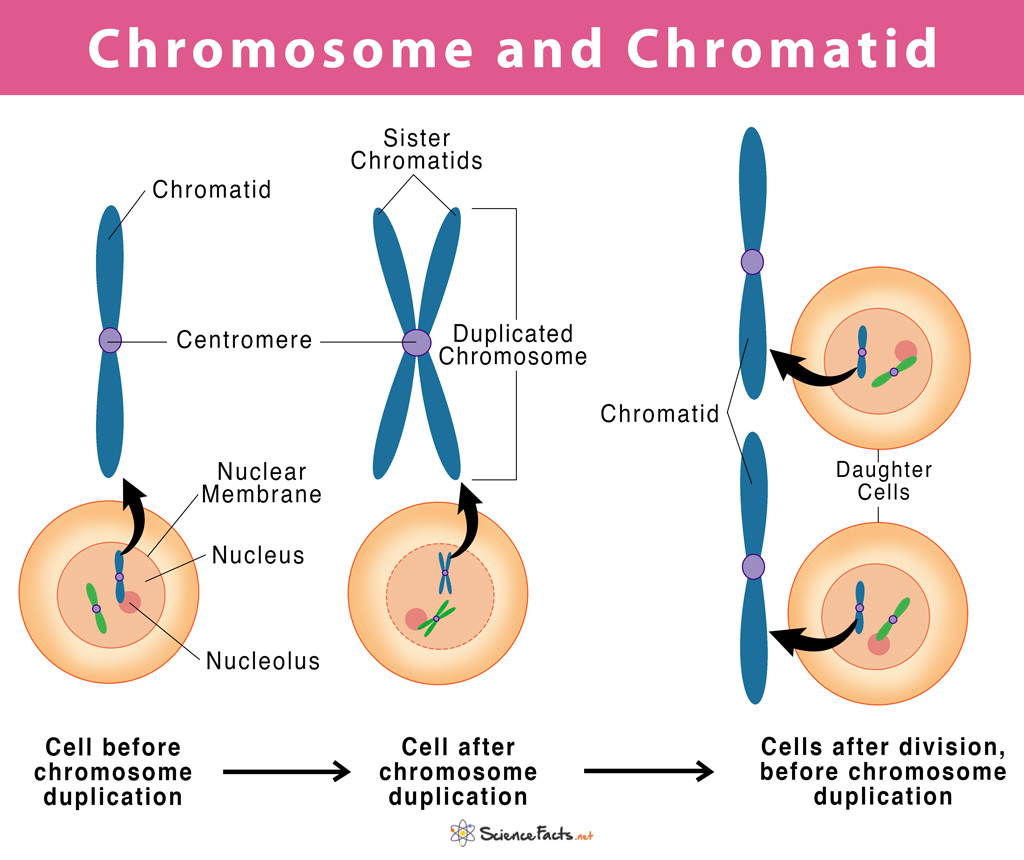Chromosome vs Chromatid
A chromosome is the most condensed form of DNA that is found during the M-phase of cell division. On the other hand, chromatin is the identical half of a duplicated chromosome, found at the interphase.
The genetic count of an organism is determined in terms of chromosome pairs; for example, humans have 46 chromosomes (arranged in 23 pairs).
How are Chromosome and Chromatid Related to Each Other
As we know, a chromosome is composed of a single DNA molecule that gets doubled during the interphase of cell division. Thus, each chromosome contains two copies of DNA strands during interphase, where each DNA strand is referred to as chromatid. In higher organisms, the double-stranded DNA wraps around a special class of proteins called histones. The association of a double-stranded DNA with its histone proteins is known as chromatin. Thus we can conclude that chromosome and chromatid are related to each other and are composed of the same basic structure.
What is the Difference between a Chromosome and a Chromatid
Chromosome vs Chromatid
| Basis | Chromosome | Chromatid |
| Consists of | A single, double-stranded DNA molecule | Two DNA strands joined together by a centromere |
| Structure | A thin, ribbon-like structure | A thin and long fibrous structure |
| Nature | Homologous chromosomes are not identical (one coming from each parent) | Sister chromatids are identical (one is an exact copy of the other) |
| Arrangement of DNA | Most condensed form of DNA | DNA is fifty times less condensed than chromosomes |
| Presence of Centromere | Present | Exclusively present in the sister chromatids |
| Occurrence | Found in cells throughout their life | Found between interphase and metaphase of cell division |
| Duplication | Chromosomes can duplicate | Chromosomes cannot duplicate |
| Functions | 1. Helps in the distribution of the genetic material, the DNA from one generation to the next 2. Packaging of DNA inside the nucleus 3. Involved in protein synthesis | 1. Maintains exact chromosome number from one generation to the next 2. Helping the cell to duplicate 3. Involved in metabolism and other cellular activities |
Similarities
- Both chromosomes and chromatids carry genetic information and are made of DNA
- Both participate in the process of cell division
- Both are located inside the nucleus of the cell in higher organisms
- In higher organisms, both contain a class of structural proteins called histones
Conclusion
Combining the differences and the similarities, we can conclude that a chromatid is always a part of a chromosome while the chromosome is made of DNA and proteins. The main difference between a chromosome and a chromatid is in the level of condensation. While DNA is condensed 10,000 times in a chromosome, it is condensed 50 times in a chromatid. Although both actively participate in the cell division process, the chromosome helps distribute genetic material from parent to daughter cells. A chromatid, on the other hand, participates in the regulation of gene expression.
FAQs
Ans. A tetrad is a structure that consists of a pair of homologous chromosomes (having four sister chromatids) formed during meiotic cell division.
Ans. DNA is the basic genetic material of a cell having a double-stranded structure that forms the basis of chromosomes along with its packaging proteins called histones. Chromatin is a decondensed or unpacked chromosome found in a cell when not in cell division. On the other hand, a chromatid is one copy of a chromosome found after chromosome division.
-
References
Article was last reviewed on Tuesday, May 16, 2023





This diagram appears to be extremely self contradictiory. In the chart it says that a chromosome is absent of a centromere which implies ecept all of the figures show the presence of a centromere including the one labeled “chromosome with one chromatid.” The “chromosome with one chromatid” label points to a structure with two stands attached by a centromere, the “one” implying that the stand itself is a chromatid except your own definition says that a chromatid has TWO strands connected by a centromere which would mean the whole structure is one chromatid even though your label says it is a chromosome with one chromatid.
The next fugures again refer to the entire strand as a chromosome but your defintion says it can’t be because the centromere should be absent. What is going on here?
We have made the necessary changes in the diagram